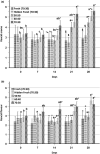Oxidative stability of direct-expanded chickpea-sorghum snacks
- PMID: 32884714
- PMCID: PMC7455968
- DOI: 10.1002/fsn3.1731
Oxidative stability of direct-expanded chickpea-sorghum snacks
Abstract
In contrast to other pulses, chickpea has a relatively high fat content (3%-10%). This study was designed to investigate direct-expanded chickpea-sorghum extruded snacks (50:50, 60:40, and 70:30 chickpea:sorghum, w/w) with respect to: their oxidative stability and sensory properties during accelerated (55°C) and room temperature (25°C) storage; correlations between chemical markers (peroxide value and p-anisidine value) and sensory data during accelerated storage; and the shelf-life of snacks extruded at the optimal expansion point as determined by a rotatable central composite design. Peroxide values and p-anisidine values were in the range of 0-2.5 mEq/Kg and 5-30, respectively, for both accelerated and room temperature storage, and increased during storage (p < .05). 70:30 and 60:40 (w/w) chickpea-sorghum snacks had higher peroxide and p-anisidine values compared to the 50:50 snack during storage at either temperature (p < .05). Rancid aroma and off-flavor of 60:40 and 70:30 chickpea-sorghum snacks (slightly intense = 6) also were higher than that of the 50:50 snack (moderately weak = 3) (p < .05). Significant correlations (p < .05) were found between chemical markers and sensory attributes (p < .05). The study illustrated that shelf-life decreased as the percentage of chickpea in the blend increased. Therefore, in terms of shelf-life, a 50:50 chickpea-sorghum blend is preferable.
Keywords: chickpea; extrusion; oxidation; sensory; shelf‐life; sorghum.
© 2020 The Authors. Food Science & Nutrition published by Wiley Periodicals LLC.
Conflict of interest statement
The authors declare no conflict of interest.
Figures



References
-
- Afify, A.‐E.‐M.‐M.‐R. , El‐Beltagi, H. S. , Abd El‐Salam, S. M. , & Omran, A. A. (2012). Oil and fatty acid contents of white sorghum varieties under soaking, cooking, germination and fermentation processing for improving cereal quality. Notulae Botanicae Horti Agrobotanici Cluj‐Napoca, 40(1), 86–92. 10.15835/nbha4017585 - DOI
-
- AOAC (1997). Association of Official Analytical Chemists standard official methods of analysis, 16th ed Gaithersburg, MD: AOAC International.
-
- AOCS (1998). Official methods and recommended practices of the American oil chemists’ society, 5th ed Urbana, Champaign, III: AOCS.
LinkOut - more resources
Full Text Sources

